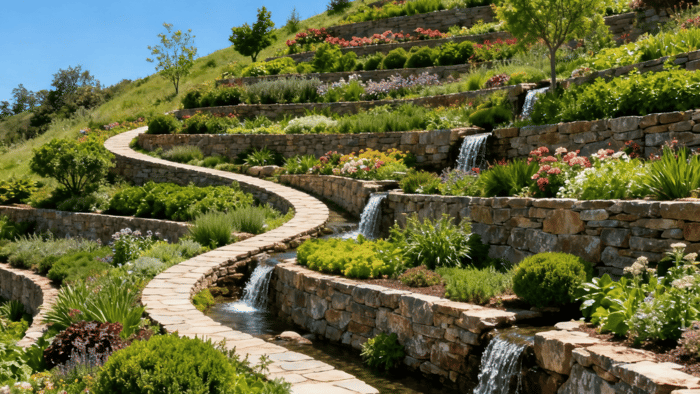Slope Reimagined: Turning Hillsides Into Living, Breathing Landscapes
Sloped land often carries the stigma of being difficult, unsafe, or unusable. Yet a growing movement among landscape designers and homeowners reveals a fascinating reframe: slopes are not just terrains to be tamed but dynamic ecosystems and enriching human environments to be embraced. Blending artistry, ecology, and engineering, modern approaches are crafting sloped landscapes into functional, beautiful, and resilient spaces. One foundational technique, tiered hillside landscaping, remains vital, frequently serving as the backbone for these innovative ideas. It reshapes inclines into layered environments that serve both nature and people.
Ecological Complexity on Slopes
Rather than fighting against sloped terrain’s natural contours and characteristics, new design philosophies emphasize working with these features to enhance biodiversity and ecosystem services. Slopes receive uneven sunlight, water runoff, and wind exposure, making them microhabitats that can support diverse plant and animal life.
By deploying careful soil management, native plantings tailored to specific gradient zones, and water-capturing terraces, sloped landscapes transform from erosion-prone areas into living, breathing ecological zones. This invites pollinators, birds, and beneficial insects that contribute to a balanced environment. The layers in tiered hillside landscaping act as ecological niches, where water is conserved and nutrients cycle naturally, rather than being washed away.
Human Interaction Redefined
Sloped landscapes are also terrains of discovery and experience. Beyond ornamental function, designers unearthed a unique opportunity to physically and emotionally engage people. Trails that spiral upward, intimate seating tucked into hillside pockets, and naturally derived pathways innovate accessibility while encouraging movement and exploration.
This approach redefines hillsides as stages for interaction—whether playful, meditative, or communal—turning them into destinations rather than barriers. The elevation difference invites panoramic views and changing sensory perspectives, offering a more immersive outdoor experience than flat ground typically allows.
Integrating Water as a Design Element
Water management is critical in slope revitalization, but many recent approaches go beyond utilitarian drainage to embrace water as an aesthetic and ecological asset. Rain gardens, bioswales, small ponds, and waterfall features become part of the layered hillside arrangement.
The retention and slow release of rainwater mimic natural hydrological processes disrupted by conventional urban grading. This limits erosion, recharges groundwater, and creates aquatic and semi-aquatic species habitats. In this context, tiered hillside landscaping supports a deliberate water choreography across different elevations for both beauty and sustainability.
Material Innovation and Sustainability
Material choices on slopes influence long-term resilience and environmental impact. Modern slope design pushes the boundaries by using recycled and locally sourced elements—stone, wood, and even salvaged metals—to construct durable retaining structures, stairways, and seating terraces.
Permeable paving and living walls reduce runoff and heat accumulation, contributing to overall sustainability. Integrating solar-powered lighting along paths and terraces ensures safety while minimizing energy consumption. These innovations reinforce sloped landscapes’ identity as spaces that responsibly marry natural cycles with human needs.
Landscape as Climate Resilience Model
In an era of increasing weather extremes, sloped landscapes designed through ecological and experiential lenses become frontline assets for climate adaptation. Their ability to slow runoff reduces flood risk downstream, while deep-rooted plants stabilize soil against landslides. Layers of tiered hillside landscaping provide redundancy, ensuring that if one zone experiences stress, others can compensate.
This layered resilience also relates to human well-being. Access to well-designed green space on slopes offers psychological benefits, including stress reduction and increased physical activity, which are critical in urbanizing societies facing multiple environmental stresses.
Toward a New Language of Sloped Landscapes
Ultimately, this evolving approach to shaping slopes calls for a conceptual shift: from seeing hillsides as obstacles to appreciating them as layered narratives of place, ecology, and human interaction. It demands care, creativity, and respect for process—a choreography between earth, water, plants, and people.
By embracing this mindset, designers and land stewards craft hillside environments that are stable and sustainable and alive with potential. This vision is accessible at different scales, from backyards to public parks, and promises to redefine how future generations connect with the undulating earth beneath their feet.
